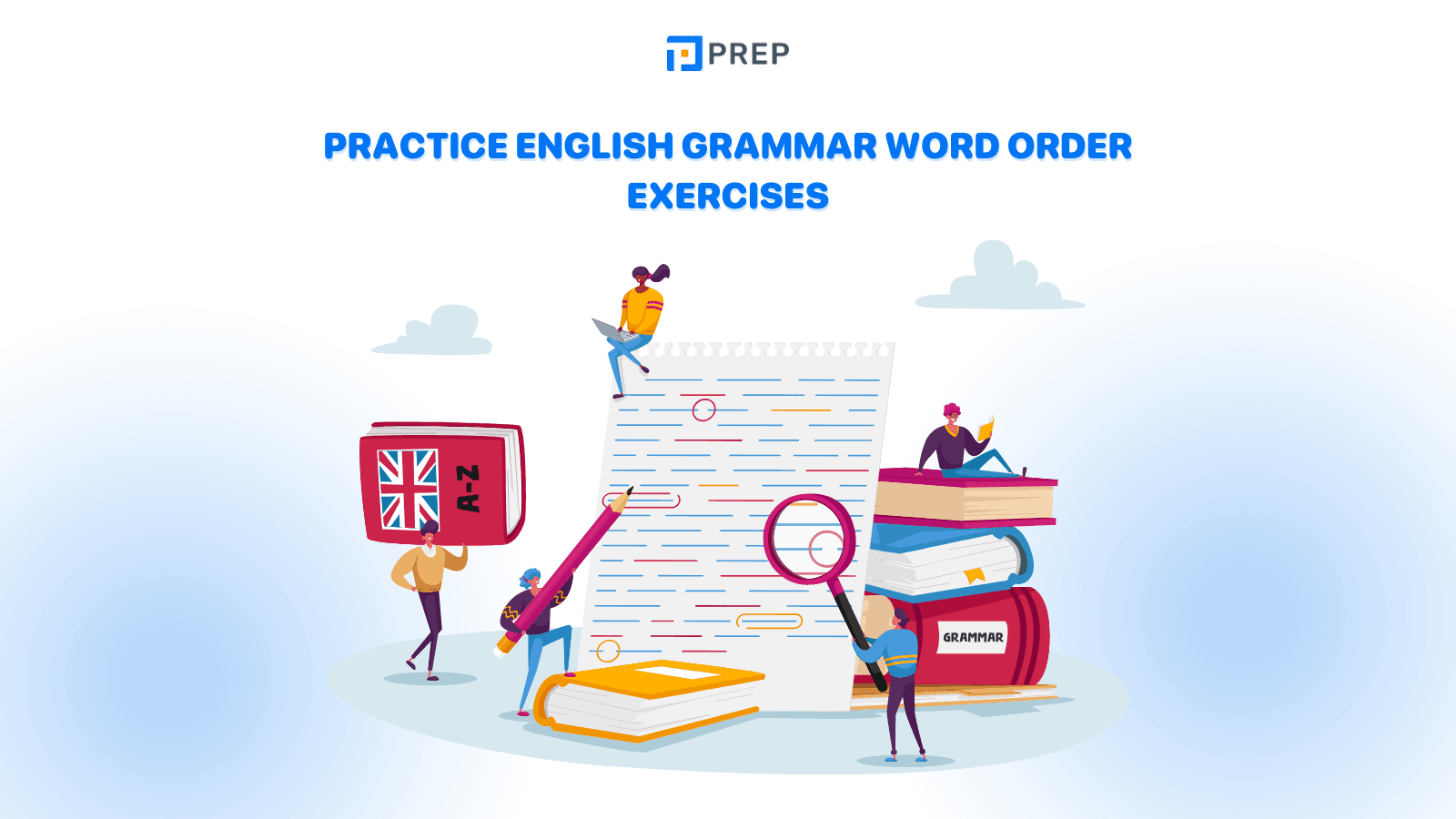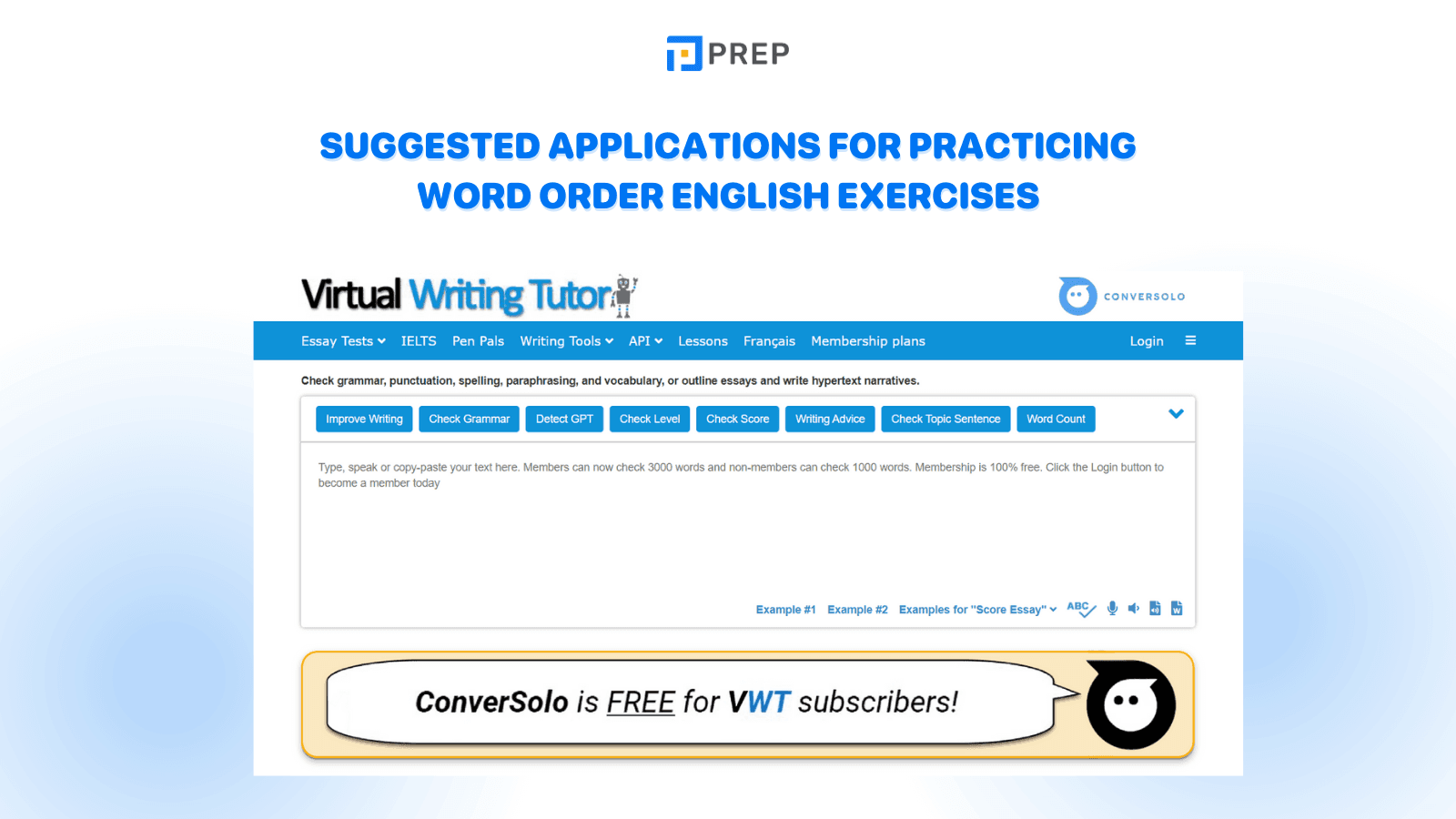Word Order English Exercises: Practice, Tips, Worksheets
Understanding English word order is essential for building correct sentences in speaking and writing. This guide explains basic rules, highlights common mistakes, and provides word order exercises with answers. Practice effectively with beginner to advanced examples.

I. Introduction to Word Order in English
In English grammar, word order refers to the arrangement of words in a sentence. A correct word order is essential to ensure that your sentences are grammatically accurate and clearly understood. Unlike some other languages that use case endings or tone markers, English relies heavily on word order to convey meaning.
Word order defines the structure of a sentence and determines how the subject, verb, and object (SVO) interact. The standard word order in English for a basic sentence is:
Subject + Verb + Object
Example: She (subject) eats (verb) an apple (object).
This pattern may seem simple, but forming more complex sentences often requires a deeper understanding of how different elements — such as adverbs, adjectives, or questions — fit into the sentence.

Basic Rules of Word Order
Some core principles to follow include:
- Adjectives usually come before nouns:
a beautiful house (not a house beautiful) - Adverbs of frequency are placed before the main verb but after the auxiliary verb:
She often plays tennis.
He has never been abroad. - In questions, auxiliary verbs come before the subject:
Do you like coffee?
Has she finished the course? - Negative sentences also follow a specific structure:
I do not understand this grammar rule.
Common Word Order Mistakes
Many English learners struggle with natural sentence structure, especially when translating directly from their native language. Common mistakes include:
- Placing adverbs in unnatural positions
(He drinks always coffee → He always drinks coffee) - Using object before subject in declarative sentences
(Went to the store she. → She went to the store.) - Mixing up auxiliary and main verbs in questions
(You do like English? → Do you like English?)
Recognizing and correcting these common patterns a critical first step—next, map how word order shifts across types of clauses in English.
II. Word Order English Exercises with Answers
Practicing English word order is one of the most effective ways to internalize proper sentence structure and improve both your speaking and writing skills. Whether you're a beginner working on the basics or an advanced learner preparing for exams like IELTS or TOEFL, structured exercises will help you identify patterns, correct mistakes, and build fluency.
Below are categorized practice activities by level, ; start with clear statements in affirmative sentences.

1. Beginner-Level Exercises
If you're just starting to learn English sentence structure, mastering basic word order is essential. At this level, learners often struggle with putting words in the correct order to form simple, clear sentences.
These beginner exercises are designed to help you improve through word rearrangement tasks focused on familiar topics such as daily routines and family.
Exercise 1: Rearrange the words to form correct sentences
Put the words in the correct order to make meaningful sentences.
- drinks / she / every morning / coffee
- to school / goes / by bike / he
- have / I / two / brothers
- usually / we / dinner / at 7 p.m. / eat
- is / a / teacher / my father
Exercise 2: Fill in the blanks with correct word order
Use the correct order of words to complete these sentences.
- ___________ (wake up / I / at 6:30) every day.
- ___________ (likes / my sister / reading books).
- ___________ (watch / they / TV / in the evening).
- ___________ (play / we / football / on Saturdays).
- ___________ (her homework / does / she / after dinner).
Exercise 3: Match the sentence parts
Match the beginnings and endings of the sentences correctly.
|
Beginning |
Ending |
|
1. My mom |
a. cleans the house on Sunday |
|
2. We always |
b. is very friendly |
|
3. The English teacher |
c. study together after class |
|
4. This cat |
d. likes milk and fish |
|
5. My friend |
e. helps me with my homework |
Answer Key
[prep_collapse_expand open_text="View more" close_text="Show less"]
|
Exercise 1 |
Exercise 2 |
Exercise 3 |
|
|
1 – a 2 – c 3 – e 4 – d 5 – b |
[/prep_collapse_expand]
2. Intermediate-Level Exercises
At the intermediate level, learners are expected to build more complex sentence structures by incorporating adverbs, adjectives, and forming questions or negations. Practicing sentence variation is crucial for expressing ideas clearly and naturally in both speaking and writing.
These exercises are designed to strengthen your understanding of word placement, improve sentence clarity, and help avoid common grammar mistakes made at this level.
Exercise 1: Add the adverb in the correct position
Rewrite each sentence by inserting the adverb in the appropriate place.
- She is tired. (always)
- They go to the gym. (usually)
- We are late for class. (sometimes)
- He visits his grandparents. (often)
- I forget my keys. (rarely)
Exercise 2: Turn the statement into a question
Change the declarative sentences into grammatically correct interrogative sentences.
- You speak English.
- She is doing her homework.
- They visited the museum.
- He has finished the report.
- You can drive a car.
Exercise 3: Use the correct word order to build a complete sentence
Arrange the words below in the correct order to form a logical sentence.
- happily / played / the children / in the park
- a / house / big / we / bought / recently
- carefully / his / reads / every day / grandfather / the newspaper
- the / finished / students / all / test / quietly
- dinner / usually / they / together / cook / on weekends
Answer Key
[prep_collapse_expand open_text="View more" close_text="Show less"]
|
Exercise 1 |
Exercise 2 |
Exercise 3 |
|
|
|
[/prep_collapse_expand]
3 . Advanced-Level Exercises
At the advanced level, learners are expected to produce accurate, complex, and well-structured sentences. Correct word order becomes even more critical in statements involving inversion, conditional structures, academic constructions, and cleft sentences.
The following exercises are designed to help you handle these complex patterns confidently, especially in high-stakes writing and speaking contexts.
Exercise 1: Apply Inversion for Emphasis
Rewrite the sentences using inversion (formal or literary style).
- Only after finishing the report, she relaxed.
- Never have I ______.
- Seldom does ______.
- Hardly had he entered the room when ______.
- Not until I asked did ______.
Exercise 2: Transform Using Conditionals and Advanced Structures
Rewrite the sentence with a new structure that keeps the original meaning.
- If I had known, I would have told you.
→ Had I known, ______. - She studies hard. She wants to pass the exam.
→ In order to ______. - The reason why he left early was that he was sick.
→ It was because ______.
Exercise 3: Correct the Word Order in Academic Sentences
Some sentences below have incorrect word order. Rewrite them correctly.
- The study clearly has shown that students benefit from online learning.
- Contributes closing the gender gap significantly women’s education.
- Discussed is in the report the financial impact of climate change.
- Was revealed in the survey the internal staff conflict issue.
- In academic writing clarity is especially important.
Answer Key
[prep_collapse_expand open_text="View more" close_text="Show less"]
|
Exercise 1 |
Exercise 2 |
Exercise 3 |
|
|
|
[/prep_collapse_expand]
III. Suggested applications for practicing word order English exercises
There are many tools/websites available that assist in grammar correction and effectively arranging word order in English sentences. During your practice, you can use supporting tools such as:
- Grammar-Monster.com
- Virtualwritingtutor.com
- Grammar.net
- Grammarly.com
- Free Grammar Check

In particular, the intelligent learning and exam preparation platform PREP offers diverse English word order exercises PDF to enhance your writing skills, complete with AI or teacher feedback.
When practicing word order English exercises with PREP, you will receive corrections, identify mistakes, and detailed analyses of your errors in writing sentences and grammar exercises. Not only for writing skills, PREP also has virtual practice rooms for listening, speaking, and reading. Give it a try!
The above includes methods for practicing word order English exercises. Let’s review thoroughly to prepare effectively for your exams and achieve high scores in real tests.

Hi I'm Chloe, and I am currently serving as an Product Content Administrator at Prep Education. With over five years of experience in independent online IELTS study and exam preparation, I am confident in my ability to support learners in achieving their highest possible scores.
Comment
Premium content
View allPersonalized roadmap
Most read












